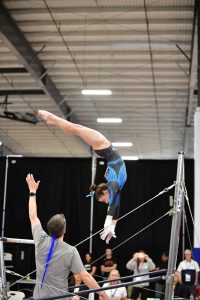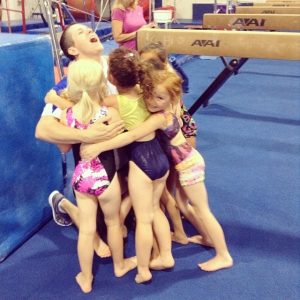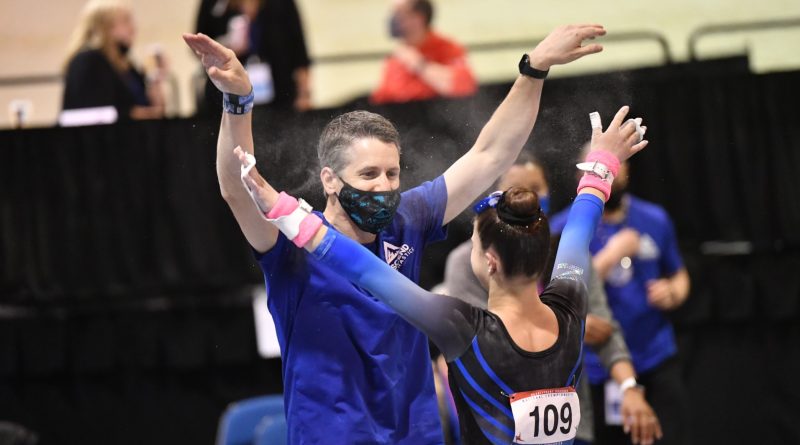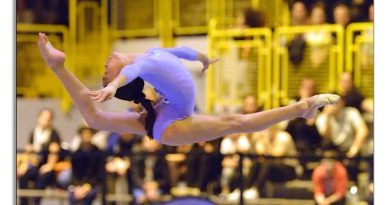What is the Technical Ceiling?
The Technical Ceiling is the maximum skill level that someone can attain based upon an individual’s technical competency/mastery. The ceiling starts at its highest point when a gymnast enters the gym for the first time. They have no bad habits because they have NO habits at all. And so the journey begins.
Every position/skill/drill has a specific window of ideal strength/timing/technique, and it is this perfect image that we attempt to teach young athletes. There is no “perfect” technique for every athlete because we must use our varying physical characteristics with the philosophy and experience of a coach to create a skill.
Every person’s body is built differently, and it is that exact reason that coaching is an art rather than a science. But there are certain mistakes and common problems that we can avoid by being very purposeful in our development path with our athletes. It is the avoidance of these mistakes and a poor developmental approach that maintains the higher Technical Ceiling in the careers of our gymnasts.
How do we discuss the Technical Ceiling within our gym?
A typical introductory conversation with parents, gymnasts, and staff often begins with the following quote: “If you don’t have time to teach it right, when will you have time to teach it again?” An explanation follows, that when we are teaching skills, sometimes it takes longer than our ideal timeline. Sometimes we don’t have that new skill “in time” for season or for a particular competition.
As coaches, we are constantly faced with the inevitable decision: Do we push forward and allow the athlete to shortcut the proper and patient development of a skill, or do we hold out and play the long game? And it is this exact choice that leads to the movement or maintenance of what we refer to as the Technical Ceiling.
Development and Progression Can’t Be Rushed
 As coaches/owners, we must recognize that everything we teach athletes from the moment they walk into our facilities will affect the long-term developmental potential of each child. Teaching with a career focus becomes a responsibility rather than simply a privilege. We strive to respect and appreciate our power within a child’s technical development in gymnastics. The quality with which we teach a handstand, cartwheel, and forward roll will significantly impact that athlete’s ability to learn and perfect top-end gymnastics.
As coaches/owners, we must recognize that everything we teach athletes from the moment they walk into our facilities will affect the long-term developmental potential of each child. Teaching with a career focus becomes a responsibility rather than simply a privilege. We strive to respect and appreciate our power within a child’s technical development in gymnastics. The quality with which we teach a handstand, cartwheel, and forward roll will significantly impact that athlete’s ability to learn and perfect top-end gymnastics.
The mental tools we teach in development will affect our gymnast’s ability in many ways. Examples are, their focus, becoming process-oriented, remaining patient, self-motivating, etc.
Fears can be built or avoided by either rushing developmental steps or sticking with solid foundational and appropriately timed progression.
How many very physically gifted athletes end up with back tumbling fears? I have seen several examples throughout my years as a coach. So often, these athletes are allowed to move fast because they are strong and gifted, without taking the extra time to develop superior understanding or control. They fly and they fall hard, and in doing so they learn, “This is scary!”
How hard is it to shepherd a young athlete through at a slow pace? A pace that seems slower than their natural ability would allow. Do we feel we are holding back an athlete in this situation, or are we playing the long game? What if we take three extra months to ensure more conceptual awareness is developed?
Without fear and with more understanding, this athlete may have an opportunity to move faster later because they have a strong foundation and have built this foundation without extra fear or punitive “crashing.” Take the fear out of the picture, and you still have an opportunity to create more control and understanding that the athlete can use to achieve more complicated skills in the future.
If the gymnast doesn’t know what she’s doing and simply “goes,” how consistent do you think they will be?
If an athlete can intentionally place her body in certain positions during skill work, the consistency should rise, and the number of turns necessary for mastery should decrease.
Drill it Down for Success!
 Drill work becomes vital to teaching our athletes more complicated skills in parts/sections with manageable expectations and standards. By creating pieces of the skill, an athlete learns to focus on certain quality standards and specific body postures or positions to attain without the fear/distraction/confusion of doing the whole skill. As these pieces gain quality and consistency, they are combined to create “the skill.”
Drill work becomes vital to teaching our athletes more complicated skills in parts/sections with manageable expectations and standards. By creating pieces of the skill, an athlete learns to focus on certain quality standards and specific body postures or positions to attain without the fear/distraction/confusion of doing the whole skill. As these pieces gain quality and consistency, they are combined to create “the skill.”
As with all things in life, the quality and the consistency of the shapes and/or positions may dull and lose their sharpness with time and repetition. When learning, we must never forget that we should dip back into the drills that made us successful. Train the same drills that created those quality results. After doing a skill for years with excellent quality and consistency, there may be a certain level of mastery attained, and only then can we reduce our drills and broken apart versions of the skill.
The Importance of Maintaining the Technical Ceiling
Without overcomplicating things, I want to leave you with the following thought. You will never be responsible for creating a ceiling above what is naturally possible for an individual athlete. Still, you certainly have an opportunity to be a part of lowering that ceiling to the point of stunting an athlete’s potential and abilities. These stunted athletes will get hurt/frustrated/achieve poor results, and they will almost always wash out of the sport at some point.
We have the ability and responsibility to maintain the Technical Ceiling as high as possible for as long as possible to avoid being part of this downward trending path for an athlete. As professionals in our industry that care about children and our sport, we must be accountable, and we must invest in teaching quality basics, fundamentals, mental tools, etc.
We hold great power to help kids reach their potential or watch them flounder and struggle mightily. Accepting this responsibility means planning, educating oneself, putting yourself and athletes in a position of success, being self-accountable, and using constant self-reflection (What part do you play and how can you improve your contributions in this process?).




